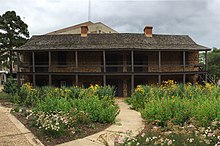Battle of Nacogdoches
The Battle of Nacogdoches was an armed conflict leading up to the Texan War of Independence . It took place on August 2 and 3, 1832 in the eastern Texas city of Nacogdoches and its surrounding area and ended with the surrender of the local Mexican garrison. In fact, the victory of the Texan colonists ended the Mexican military presence in East Texas. Historically, the battle is an important milestone on the way to the open separation of the province of Texas from Mexico and the War of Independence in 1836.
background
The background to the battle between the Texan settler militias and the local Mexican garrison , which took place in August 1832, was the situation in the Mexican province of Texas, which was characterized by growing political uncertainty, discontent and power struggles. Since the Louisiana Purchase in 1803, which was concluded between the United States and France and added large areas in the west to the territory of the United States, Spanish-Mexico had made increased efforts to colonize the Texas border areas in the north. The Republic of Mexico continued these efforts. After the allocation of several land charter in the course of the 1820s, a steadily increasing Anglo-Saxon settlement began in East and Central Texas . The Anglo-Saxon settlements, which were striving for (more) autonomy , increasingly came into conflict with the Mexican administration.
These conflicts were intensified by the internal Mexican power struggles between federalists and centralists . After Mexican troops and Texan settlers put down an isolated uprising in East Texas , the Fredonian Rebellion , the central government in Mexico City passed a law that severely restricted the expansion of further Angleno settlements. Since this law was initiated by the centralists who were currently in power, the Texan settlers placed high hopes on their domestic opponents, the federalists.
course
The trigger for the armed conflict of August 2 and 3, 1832 was an order from the military commander of Nacogdoches José de las Piedras to the local colonists to surrender their weapons . Gun stocks had been confiscated in the past. However, these were carried out pro forma rather than real. As it was foreseeable that the federalist faction with General Santa Anna would prevail in the inner-Mexican power struggle , the local colonists went on a confrontational course and on July 28th sent messengers to the surrounding colonies to organize support. The spontaneously formed militia that gathered in Pine Hill on August 1 comprised around 300 men - including contingents from the Ayish Bayou , San Augustine , Neches and other settlements on the Sabine River . James W. Bullock was elected to command the company.
Reinforced by another troop under James Bowie, the troop advanced on Nacogdoches to submit their demands to Piedras and force him to declare himself for Santa Anna and his federalists. Piedras refused the request and had a unit of 100 Mexican cavalrymen advance against the militia troops. The ensuing fighting soon developed into a house-to-house battle , in the course of which the Texans advanced step by step into the city and, among other things, occupied the Old Stone Fort, one of the two important buildings in the city. To escape the looming siege , the Mexicans withdrew into the main fortification, the Old Red House. In the meantime, a second center of fighting had developed in the north of the city. Here, too, the Texans succeeded in driving the Mexican cavalry back into the fortification and tying them there.
During the night, Piedras evacuated the Mexican garrison from the city. The Texan militia pursued the fleeing Mexicans and placed them on the Angelina River the following day . After a mutiny against Piedras, Colonel Francisco Medina took command. Medina declared herself a federalist, capitulated and handed Piedras over to the Texans. These escorted the defeated Mexican garrison first back to Nacogdoches and then to San Antonio , where they were released. Piedras was escorted to Stephen F. Austin's charter colony in San Felipe and released there as well.
consequences
The losses in the fighting amounted to 47 dead and 40 injured among the Mexicans, three dead and four injured among the Texans. The immediate effect of the battle was that no Mexican troops were stationed in East Texas until the outbreak of the Texan Revolution . Another conflict continued to smolder even after the fighting ended - that between Anglo-Saxon new settlers and the Spanish-speaking old settlers, the so-called Tejanos , who had lived in the region for generations . At the Battle of Nacogdoches, the latter had mostly sided with the federalist side and thus with the Texan colonists. After the War of Independence, the smoldering power struggle in the newly founded state culminated in another local conflict: the Córdova Rebellion 1838 - a survey led by the landowner Vincente Córdova, which was put down with the help of the newly established Texas Rangers police force .
Individual evidence
- ↑ a b c d e Nacogdoches, Battle of . Archie P. McDonald, Texas State Historical Association (TSHA), June 15, 2010
- ↑ a b c d e Anahuac, Velasco & Nacogdoches Summer 1832 . Wallace L. McKeehan, sonsofdewittcolony.com, 1997-2001 (Engl.)
- ^ Nacogdoches County . Christopher Long, Texas State Historical Association (TSHA), June 15, 2010 (Engl.)
- ↑ a b The Battle of Nacogdoches . Jamal Tuschick, Friday, March 8, 2018
- ↑ a b c Disturbance of 1832 . Archie P. MacDonald, Texas Escapes, April 6, 2012 (2003) (Engl.)


